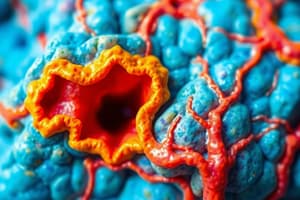Podcast
Questions and Answers
Which type of tissue enables voluntary movement by attaching to bones?
Which type of tissue enables voluntary movement by attaching to bones?
- Skeletal muscle (correct)
- Fibrocartilage
- Elastic Cartilage
- Smooth muscle
What is the main function of nervous tissue in the body?
What is the main function of nervous tissue in the body?
- Internal communication (correct)
- Support
- Protection of organs
- Anchoring other tissues
Which type of tissue lines hollow organs to facilitate the movement of substances through them?
Which type of tissue lines hollow organs to facilitate the movement of substances through them?
- Fibrocartilage
- Smooth muscle (correct)
- Elastic Cartilage
- Bone (Osseous Tissue)
Which of the following is NOT one of the basic types of tissue in the body?
Which of the following is NOT one of the basic types of tissue in the body?
What is the primary function of epithelium in the body?
What is the primary function of epithelium in the body?
How many types of neurons are mentioned in the text under nervous tissue?
How many types of neurons are mentioned in the text under nervous tissue?
What is the main function of reticular connective tissue?
What is the main function of reticular connective tissue?
Which type of collagen is described as tough and providing strength?
Which type of collagen is described as tough and providing strength?
What is the main function of adipose (fat) tissue?
What is the main function of adipose (fat) tissue?
Which shape best describes cuboidal epithelial cells?
Which shape best describes cuboidal epithelial cells?
What is the main role of bone tissue in the body?
What is the main role of bone tissue in the body?
What is the main function of cardiac muscle?
What is the main function of cardiac muscle?
Which type of muscle responds to involuntary signals?
Which type of muscle responds to involuntary signals?
What is a characteristic feature of epithelial tissues?
What is a characteristic feature of epithelial tissues?
How are cardiac muscle cells connected to each other?
How are cardiac muscle cells connected to each other?
Which type of muscle is composed of long cylindrical and striated fibers?
Which type of muscle is composed of long cylindrical and striated fibers?
What is the main difference between skeletal and cardiac muscles?
What is the main difference between skeletal and cardiac muscles?
Flashcards
Skeletal muscle function
Skeletal muscle function
Enables voluntary movement by attaching to bones.
Nervous tissue function
Nervous tissue function
Facilitates internal communication throughout the body.
Smooth muscle function
Smooth muscle function
Lines hollow organs to facilitate movement of substances through them.
Epithelium function
Epithelium function
Signup and view all the flashcards
Reticular connective tissue function
Reticular connective tissue function
Signup and view all the flashcards
Type I collagen
Type I collagen
Signup and view all the flashcards
Adipose (fat) tissue function
Adipose (fat) tissue function
Signup and view all the flashcards
Cuboidal epithelial cells shape
Cuboidal epithelial cells shape
Signup and view all the flashcards
Bone tissue function
Bone tissue function
Signup and view all the flashcards
Cardiac muscle function
Cardiac muscle function
Signup and view all the flashcards
Cardiac muscle control
Cardiac muscle control
Signup and view all the flashcards
Epithelial tissue features
Epithelial tissue features
Signup and view all the flashcards
Cardiac muscle cell connection
Cardiac muscle cell connection
Signup and view all the flashcards
Cardiac muscle composition
Cardiac muscle composition
Signup and view all the flashcards
Skeletal vs. Cardiac muscle func.
Skeletal vs. Cardiac muscle func.
Signup and view all the flashcards
Study Notes
Tissue Types
- There are 4 main tissue types: epithelial, connective, muscle, and nervous tissue
Epithelial Tissue
- Forms boundaries between different environments
- Secretes, protects, absorbs, and excretes
- Found on skin surface and surrounding glands
- 2 forms: covering and lining epithelium, and glandular epithelium
- Characteristics: polarity, specialized contacts, supported by connective tissue, avascular, and innervated
Connective Tissue
- Supports, anchors, and protects
- Found in bones, tendons, fat, and other soft tissues
- Types of connective tissue: bone, cartilage, adipose, and connective tissue proper
- Components: ground substance, fibers, and cells
Muscle Tissue
- 3 types: skeletal, smooth, and cardiac
- Skeletal muscle: attaches to bone, enables voluntary movement
- Smooth muscle: found in hollow organs, helps move substances through
- Cardiac muscle: found in heart, propels blood throughout body
Nervous Tissue
- Enables internal communication between brain, spinal cord, and nerves
- 2 major cell types: neurons and glial cells
- Neurons: basic unit of nervous system, transmit and process information
- Glial cells: provide support, protection, and maintenance functions
Studying That Suits You
Use AI to generate personalized quizzes and flashcards to suit your learning preferences.




